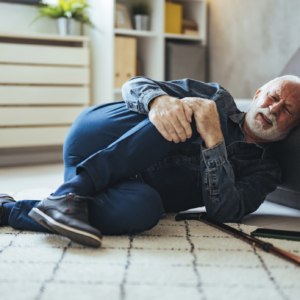Common But Preventable: Injuries And Deaths Due To Falling

Common But Preventable: Injuries And Deaths Due To Falling
April 3, 2024
We’ve quoted the statistics before: One out of every four older adults has a fall every year, and one out of every five falls results in a serious injury, including hip fractures (95% of hip fractures are due to a fall) and head injuries leading to death. We previously highlighted the death of comic actor Bob Saget due to a fall-induced head injury and yet again, this past week, came the unfortunate news that politician and former Vice-Presidential candidate Joe Lieberman also died as the result of a fall. Mr. Lieberman’s fall occurred at his home, the place where most older adult falls occur. Specifically, using emergency room data, it’s been found that the majority of falls at home occur in either the bedroom, bathroom, or stairway. Writing after the death of Joe Lieberman, emergency medicine physician Jason Bae commented that “it’s rare to go a day without seeing an older patient for a fall-related injury.” He went on to say, “Aging and dying may be inevitable, but falls are not.” Researchers suggest that ⅓ – ⅔ of falls are preventable.
We’ve previously addressed factors that can influence your risk of falling and prevent fall injuries: whether it’s increasing your strength and balance, improving your flexibility, reviewing your medications for those that cause dizziness or have harmful interactions, wearing appropriate footwear, removing tripping hazards, increasing lighting, ensuring handrails on steps and in bathrooms, using adaptive medical equipment, or attending to vision or hearing problems. A recent article from US News goes into great detail about all of the ways you can keep yourself or a loved one safe at home. Beyond what’s already been described, the article suggests attention to vitamin levels (Vitamin D and B12 deficiencies can be a possible culprit) and avoidance or limits on alcohol consumption. As the post makes clear, “Anything more than a drink a day significantly increases risks of falls.”
There is additional recent research that sheds further light on risk factors along with prevention efforts. A new study published in Nature Scientific Reports describes an association between hypertension (high blood pressure) and elevated risk of falling, perhaps either due to medications taken to address hypertension or gait or balance problems due to hypertension. Thus, those who have high blood pressure may want to take extra precautions to prevent falls. Another recent study published in JAMA Internal Medicine cited the use of opioids in adults aged 85 and older as a significant risk factor for falling. The research demonstrated that those prescribed opioids had a 6x higher risk of falling than a comparable group who did not take opioids. Especially in the first four weeks of initiating opioids, it’s suggested that targeted fall prevention efforts be initiated to lower the risk of a potential fall.
Regarding prevention efforts, a new study in JAMA Network Open reports that among older women, being active for 30 minutes a day, 5 days a week can help prevent falls and fall injuries. Older women who engaged in this level of activity were up to ⅓ less likely to hurt themselves in a fall. Taking a brisk walk and doing tai chi can also lower the risk of falling in older adults. Dr. Leslie Kernisan from Better Health While Aging recently posted about the need for strength training and balance exercises as being critical to lowering your risk of falls along with giving you the reserve you’ll need if you’re recovering from a fall injury. For some examples of easy-to-do balance exercises, get ready to move and click here.
Finally, with increasing technological sophistication, wearable devices are better able to detect a fall risk or alert if there’s been a fall. Take a look here at an analysis of Apple phone features that may predict a greater chance of risk and read here about the latest available options for fall detection devices.







